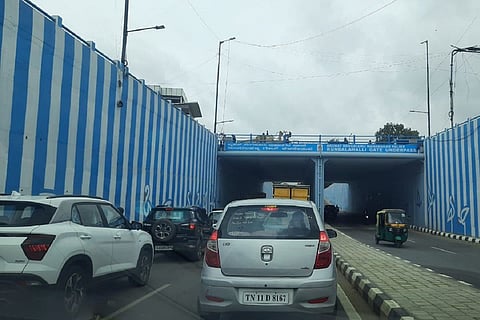

The increasing number of underpasses in Bengaluru have done nothing to decrease the flow of traffic in the city. Still touted as the primary solution for congestion by the Bruhat Bengaluru Mahanagara Palike (BBMP), underpasses have only increased commuters’ woes. Flooding and waterlogging in and around crucial underpasses during monsoon season, jam-packed roads, lack of adequate mass public transport, large-scale road digging by various state agencies, have added significantly to the city’s infamous traffic snarls.
Recently, Bengaluru Agenda for Mobility, a citizen’s campaign for sustainable, multi-modal integrated mobility raised concerns over the newly built Kundalahalli underpass, drawing attention to ways in which it adds to the traffic congestion. People critical of the utility of underpasses and flyovers in the city, consider construction of such infrastructure as a digression from what needs to be done—formulation of a city development plan that complements the comprehensive mobility plan of Directorate of Urban Land Transport (DULT).
“We need to have a systemic approach to town planning. When we are looking at the city of Bengaluru, it is not just one area that is congested. The entire city is congested. There is a traffic jam every 200-500 meters, so building one underpass somewhere solves nothing. You are easing traffic at one choke point only to shift that congestion to another point. This is what happened with the Kundalahalli underpass, it freed up the clogged Kundalahalli junction, but now the time taken by vehicles at the next choking point has increased. What have we really solved?” asks Sandeep Anirudhan, civic activist and co-founder Bengaluru Agenda for Mobility.
Underpasses and flyovers in the city need to be strategically positioned and should not be presented as an end-all solution to traffic congestion when it is only a temporary fix. “No matter how much you widen the roads or build flyovers, it won’t really do much considering the number of private vehicles in the city only keeps increasing. Hence, what we need is effective public transport so that people are incentivised to shift from their personal vehicles to buses and trains. The more people travel by public transport, the less will be the use of private vehicles. That is when we will solve Bengaluru’s traffic woes,” says Sandeep Anirudhan.
The city is in need of a mass transit system that is well connected and a Unified Transport Authority could ensure that all the public modes of transport in the city can provide seamless connectivity to citizens. Naresh Narasimhan, an architect, and urban designer told TNM that underpasses, when engineered rightly, do alleviate some issues, but are susceptible to flooding. Most of the underpasses lack a proper drainage system, an engineering problem which the BBMP needs to fix. “It needs efficient design with dewatering pumps and a standby pump in case the former fails. Unfortunately, that is rarely implemented, and when it's done, it is never maintained. A lot of places have a high groundwater table, so it is hard to avoid flooding in such cases, which is why underpasses in many places are not functional at all,” says Narasimhan.
He also draws attention to the government’s misdirected approach to development, “I do not understand why flyovers are synonymous to development in the city, or why cars are given privilege over the pedestrian,” he says.